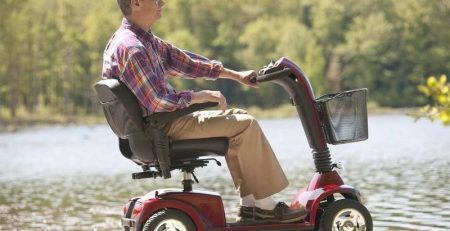- No products in the cart.
How to safely transport your mobility equipment
Getting a mobility equipment can be a life-changing decision for someone who has difficulty getting around. Once they get their piece of equipment, they may think it’s “off to the races” and they will immediately be able to begin using it. However, it’s important for users of mobility equipment, including mobility scooters and walkers, to be aware of how they can safely move their equipment from one place to another. This will allow them to maximize their independence across all settings and live the active life they always dreamed of.
A big part of transportation is loading your mobility equipment into the trunk of your car or the rear of your van or SUV. Individuals who use public transportation will also want to be well-versed in how to safely take and stow their mobility equipment on buses, trains, and trolleys. Here, we describe how you can properly transport your device as needed throughout the community.
Individuals looking to move their device in a car will first want to be sure they are safely able to do this on their own. It is quite counterproductive for someone with a mobility concern to seek the assistance of a mobility equipment, only to soon after get injured trying to store it themselves.
Walkers
Most standard walkers can easily be folded with the press of one button on each side, which folds each of the legs inward. This allows the walker to lay flat and, due to their lightweight aluminum structure, individuals do not have to exert much effort to lift and place flat in the trunk. For even more ease of use, standard walkers can even be propped up against the backseat of their car to avoid walking around the back or closing a large trunk door.
As for rollators (walkers with built-in seats), there is typically one knob on the side of the seat. This knob can be pulled out, which allows you to then tug on a cord hidden inside the seat. This lifts the seat upward and manually helps you fold the rollator to lay flat. Once the rollator is flat, it can be stowed in much the same way as a standard walker. However, rollators are often a bit heavier due to the presence of the seat, so you will want to do a trial run to be sure you can lift it safely before you absolutely need to transport it.
Wheelchairs
Whether discussing full-sized manual wheelchairs or lighter transport chairs, these mobility equipment differ quite a bit from the simplicity of the walker and rollator. Some more complicated wheelchairs (those intended for full-time users with complex medical needs) do not have a folding option. In this instance, these mobility equipment will need to be wheeled into the back of a van using a ramp or lifted several feet while in the upright position to be placed into a van. Individuals will need assistance for these devices, as they are bulky and can pose a safety risk to anyone with balance issues or impaired strength.
Regular wheelchairs can also be on the heavier side due to large wheels and supportive seating options. However, these options often fold by firmly grasping both the front and back of the seat while pulling both inward. This allows the seat of the chair to fold in an accordion-like manner while the wheels act as bookends on either side. Some individuals who only use their wheelchair part-time may be able to lift a wheelchair like this without assistance, but it is usually recommended that individuals seek help from someone for the purpose of transporting.
Transport chairs, on the other hand, are lightweight and weigh a bit more than a rollator does. These chairs fold in a similar manner as regular wheelchairs, but individuals may be able to lift them into the car on their own. Even so, many transport chairs are caregiver-attended, meaning they will need to be pushed and steered by another individual. So, in such cases, the caregiver who assists in pushing the transport chair user can also assist in loading and unloading it in the vehicle.
Power chairs
Now, these mobility equipment are a bit more complicated and are not intended to be flattened or disassembled to stow during transport. Therefore, individuals wishing to transport power chairs for use within the community (or elsewhere) should have access to an adapted van. For safe transport of a power chair, the adapted van should have a motorized ramp that is lowered to the ground once the back hatch is opened. In this case, individuals can easily remain in their power chair and drive it directly on to the van.
A similar process takes place on public transportation such as buses and trains. In addition to a variety of safety protocols mandated by the American Disability Association (ADA), buses and trains have a handicap-accessible door that must be engaged for individuals traveling in power chairs. Once this is engaged, the door slowly opens, a platform is lowered to the ground, and power chair users can drive on. Once they are safely loaded and strapped in as needed, the platform is raised to meet the rest of the vehicle, the door closes, and they are safely ready to depart to their destination.
Mobility Scooters
There is not nearly as much possibility with scooters, since individuals who use these mobility equipment have much more range and can travel across short distances within the community safely. Individuals who are looking to transport this scooter across longer distances such as for vacation or a road trip would need to disassemble it and reassemble it. While there are usually only 4-5 major parts that make up mobility scooters, this process would require assistance, as the parts are bulky and need to be connected correctly in order to safely use the scooter.
As you can see, there are a range of possibilities that individuals can take advantage of for transporting their mobility equipment to and from their places of choice. Individuals who would like more concentrated assistance in selecting a device that accommodates their lifestyle, including transportation needs and more, should speak with a healthcare provider or a mobility specialist. This will allow them to choose a device that best suits their needs.













